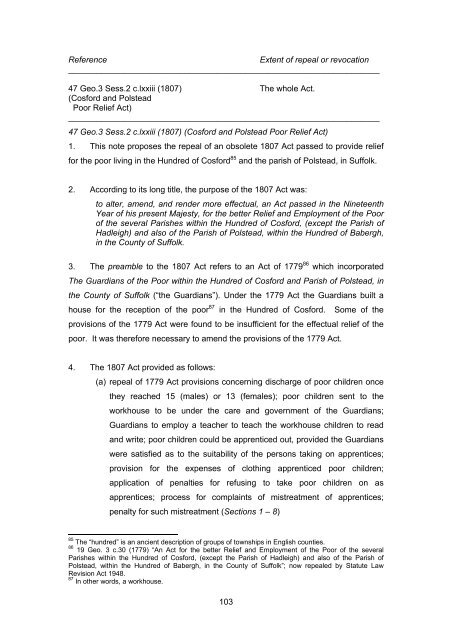Poor Relief - Law Commission
Poor Relief - Law Commission
Poor Relief - Law Commission
You also want an ePaper? Increase the reach of your titles
YUMPU automatically turns print PDFs into web optimized ePapers that Google loves.
Reference Extent of repeal or revocation<br />
___________________________________________________________________<br />
47 Geo.3 Sess.2 c.lxxiii (1807)<br />
(Cosford and Polstead<br />
<strong>Poor</strong> <strong>Relief</strong> Act)<br />
The whole Act.<br />
___________________________________________________________________<br />
47 Geo.3 Sess.2 c.lxxiii (1807) (Cosford and Polstead <strong>Poor</strong> <strong>Relief</strong> Act)<br />
1. This note proposes the repeal of an obsolete 1807 Act passed to provide relief<br />
for the poor living in the Hundred of Cosford 85 and the parish of Polstead, in Suffolk.<br />
2. According to its long title, the purpose of the 1807 Act was:<br />
to alter, amend, and render more effectual, an Act passed in the Nineteenth<br />
Year of his present Majesty, for the better <strong>Relief</strong> and Employment of the <strong>Poor</strong><br />
of the several Parishes within the Hundred of Cosford, (except the Parish of<br />
Hadleigh) and also of the Parish of Polstead, within the Hundred of Babergh,<br />
in the County of Suffolk.<br />
3. The preamble to the 1807 Act refers to an Act of 1779 86 which incorporated<br />
The Guardians of the <strong>Poor</strong> within the Hundred of Cosford and Parish of Polstead, in<br />
the County of Suffolk (“the Guardians”). Under the 1779 Act the Guardians built a<br />
house for the reception of the poor 87 in the Hundred of Cosford. Some of the<br />
provisions of the 1779 Act were found to be insufficient for the effectual relief of the<br />
poor. It was therefore necessary to amend the provisions of the 1779 Act.<br />
4. The 1807 Act provided as follows:<br />
(a) repeal of 1779 Act provisions concerning discharge of poor children once<br />
they reached 15 (males) or 13 (females); poor children sent to the<br />
workhouse to be under the care and government of the Guardians;<br />
Guardians to employ a teacher to teach the workhouse children to read<br />
and write; poor children could be apprenticed out, provided the Guardians<br />
were satisfied as to the suitability of the persons taking on apprentices;<br />
provision for the expenses of clothing apprenticed poor children;<br />
application of penalties for refusing to take poor children on as<br />
apprentices; process for complaints of mistreatment of apprentices;<br />
penalty for such mistreatment (Sections 1 – 8)<br />
85 The “hundred” is an ancient description of groups of townships in English counties.<br />
86 19 Geo. 3 c.30 (1779) “An Act for the better <strong>Relief</strong> and Employment of the <strong>Poor</strong> of the several<br />
Parishes within the Hundred of Cosford, (except the Parish of Hadleigh) and also of the Parish of<br />
Polstead, within the Hundred of Babergh, in the County of Suffolk”; now repealed by Statute <strong>Law</strong><br />
Revision Act 1948.<br />
87 In other words, a workhouse.<br />
103
















